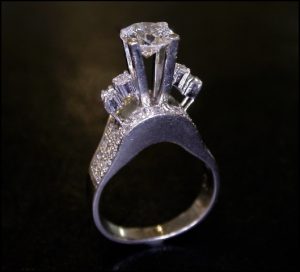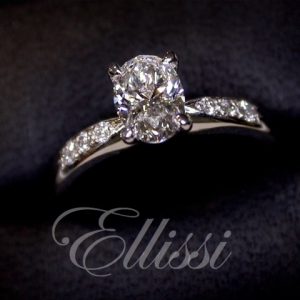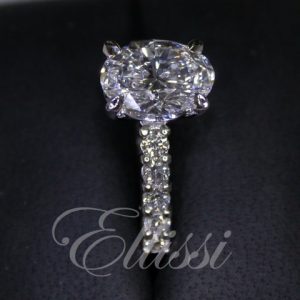Engagement ring settings tend to change over time as fashions change. Of course there is the timeless “Tiffany” setting that we all think of when we think of an engagement ring. But just as clothing fashions change, so too does the way in which we look at different setting styles.
 Does anyone remember the diamond rings of the 70’s, with the sky-high settings that were so chic at the time? A client’s mother recently brought her engagement ring of this era to us to see if it were possible for us to lower the setting. We had all forgotten just how outrageous these rings were! (Yes, sadly we are just old enough to remember our mothers wearing rings just like this).
Does anyone remember the diamond rings of the 70’s, with the sky-high settings that were so chic at the time? A client’s mother recently brought her engagement ring of this era to us to see if it were possible for us to lower the setting. We had all forgotten just how outrageous these rings were! (Yes, sadly we are just old enough to remember our mothers wearing rings just like this).
Hopefully it will be a while before that style of setting returns as a “must have” for the young and fashionable.
We can set precious gemstones such as diamonds and sapphires in a number of different ways. In this series of articles, we look at some of the engagement ring settings that are popular today.
The terminology used on the net to describe different settings is often incorrect. If you are having difficulty in working out what is what, these blogs will (hopefully) set you straight!
Engagement Ring Settings
Firstly we will have a look at a couple of different types of claw settings that we make today. Thankfully they are both completely different to the claw settings of the ’70’s!
“Claw Set” and “Grain Set”
Commonly called “prong set” in the US, claw set is one of the most popular engagement ring settings we see today.
 The ring on the left combines two types of engagement ring settings, “claw set” and “grain set”.
The ring on the left combines two types of engagement ring settings, “claw set” and “grain set”.
The main oval cut diamond is claw set. In this ring the claws taper to a point. We call this particular type of claw setting a “tiger claw” setting. This shape claw really enhances the look of the diamond. The setting draws your eye in to the diamond, which is of course the main feature of the ring.
The round brilliant cut diamonds in the shoulder are “grain set”. This is where the setter pushes little slivers of gold up from the gold in the ring. They then form this metal into a small bead that holds the diamond. This process is called “raising the grains.”
There is always a minimum of two grains to hold the diamond, but more commonly four.
In this ring the round diamonds are grain set with a polished edge.
“Tiger Claw” Set and “Shared Claw” Set
The ring below, a real stunner, also has two different types of claw settings. Like the ring we just looked at, four tiger claws are holding the central round cut diamond in place. Claw setting is very versatile. It suits nearly every diamond shape.

The diamonds in the band are set in a different way in this ring. They are held in place by what is called “shared claws”. This is where the one claw holds onto the diamond on either side of it.
If not set properly, it is possible that a diamond could fall out. If the claw were to come off completely, there is the danger that both of the diamonds that the claw holds could fall out.
This is where the skills of the diamond setter really come into play. A good diamond setter is literally worth their weight in gold!
There are a lot of different setting styles that we use for different ring designs. We’ll look at a few more in the next blog!

